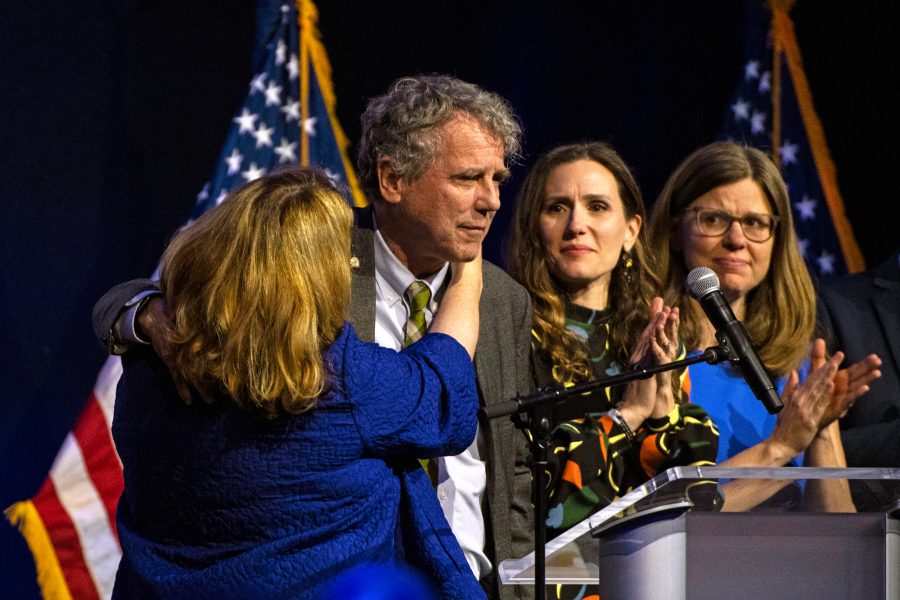Plastics Pollution Has Become a ‘Crisis,’ Biden Administration Acknowledges
Single-use plastic would be phased out of all U.S. government operations by 2035 under a new federal plastics pollution strategy unveiled Friday by President Joe Biden’s administration, which cited a “crisis” of littered oceans and poisoned air due to plastics.
“The Federal government is—for the first time—formally acknowledging the severity of the plastic pollution crisis and the scale of the response that will be required to effectively confront it,” said Brenda Mallory and Ali Zaidi, the top White House environmental and climate officials, in the joint letter that opens the 83-page document.
Noting that plastics production and waste have more than doubled in the past two decades, and are expected to increase four-fold by 2050, they said action is needed to address impacts throughout the plastic lifecycle, from production to end-of-life, with a coordinated response at all levels of government.
Plastic is “now found almost everywhere on our planet, from floating garbage patches in the Pacific Ocean to nearly every waterline, coastline, and shore line, including beaches and river banks,” the document said. It talked about local municipalities being burdened with the cost of plastics pollution, the risks to human health from microplastics and how production and transport of fossil fuel-derived plastics are contributing to greenhouse gas pollution and exacerbating climate change.
Explore the latest news about what’s at stake for the climate during this election season.
But the new White House strategy doesn’t call for steps that would directly curtail production. Instead, it endorses stronger regulation of air and water pollutants from plastic production plants, support of research into plastic alternatives, and investment in improvements in waste management.
Environmental advocates praised the Biden administration for spelling out the full scope of the plastics problem, including air and water pollution from production, in a way they haven’t done before. But they said the measures still fall short of what is needed to stem the rising tide of plastics pollution.
“It seems to go further than any previous singular federal action on plastic pollution, acknowledging some key truths about this planetary crisis,” said Jen Fela, vice president of programs and communication for the Plastic Pollution Coalition. “However, the U.S. government really needs to now ensure that the actions it takes are commensurate with the urgency of the problem, and are fully in line with these truths.”
Not Turning Off the Tap
Last month, the federal agency responsible for procurement, the General Services Administration, finalized a plastics reduction rule that many environmentalists viewed as too weak. It sought to encourage, rather than require, less use of throw-away plastic items, in part by deploying a new icon that federal contractors could use to label their products to make it easier for federal purchasers to identify select products free of single-use plastic packaging.
The new goals set by the Biden administration, which do not have the force of law and could be abandoned by a future administration, would go further—phasing out single-use plastic by food service operations, events and in packaging by 2027, and from all federal operations by 2035.
“To truly solve this problem, we need to limit plastic production globally, and the U.S. could really lead in that.”
The strategy document also references the two-year-old effort now underway to develop an international plastics treaty, with negotiations slated to conclude this year. “Reaching a strong global agreement can help turn the tide against the sea of plastic pollution that is rising around the world,” wrote Mallory and Zaidi.
But the Biden administration has faced sharp criticism for doing too little to ensure that a strong treaty emerges. The United States, the world’s leading producer of the oil and gas that is feedstock for plastics, has joined with the fossil fuel industry in resisting a call to include caps on plastics production in the pact, and the new strategy does not talk about any change in that stance.
Fela said that in many ways, the new strategy calls for continuing what the government has been doing for decades—focusing on better waste management and cleanup of plastic instead of the idea of making less of it. “That’s mopping the floor instead of turning off the tap,” she said. “To truly solve this problem, we need to limit plastic production globally, and the U.S. could really lead in that. That still seems to be the thing that they’re not willing to do.”
The new strategy document, called “Mobilizing Federal Action on Plastics Pollution: Progress, Principles, and Priorities,” cites a number of steps that are already underway. For example, it cites the State Department’s launch last year of a public-private partnership, the End Plastic Pollution International Collaborative, with $15 million in initial U.S. funding.
In addition, the strategy includes programs under the bipartisan 2021 Infrastructure Investment and Jobs Act, such as the Environmental Protection Agency spending $275 million to improve solid waste infrastructure for recycling, the largest such investment by the federal government. Also using money Congress provided under the infrastructure law, the National Oceanic and Atmospheric Administration is devoting nearly $70 million to projects that will remove large marine debris throughout the coastal United States, the Great Lakes and territories. And in 2022, Interior Secretary Deb Haaland issued an order to phase out single-use plastics on land the department manages, including national parks, by 2032.
The document notes that environmental justice advocates have called for action for years on the unfair burden of pollution from petrochemical plants borne by poor communities and communities of color.
“There is much work to be done, but the Biden-Harris Administration is committed to ongoing engagement to help ensure that all communities are able to breathe clean air, drink clean water, and live in a healthy environment,” the strategy document said.
To address the environmental justice problem, the Biden document focuses on regulation of production pollution, noting that the EPA finalized rules this year to reduce emissions of toxic air pollutants that come from such facilities, including ethylene oxide and chloroprene. The EPA has also started the process of prioritizing other plastics production chemicals, including vinyl chloride and seven phthalate chemicals, for risk evaluations under the Toxic Substances Control Act.
But Fela noted that scientists have identified some 4,200 chemicals in plastics manufacturing that could be harmful to human health or the environment. “Doing each of these chemicals one by one is not going to get us there quick enough,” she said. “The frontline communities that are being impacted by these chemicals don’t have any time to waste.”
About This Story
Perhaps you noticed: This story, like all the news we publish, is free to read. That’s because Inside Climate News is a 501c3 nonprofit organization. We do not charge a subscription fee, lock our news behind a paywall, or clutter our website with ads. We make our news on climate and the environment freely available to you and anyone who wants it.
That’s not all. We also share our news for free with scores of other media organizations around the country. Many of them can’t afford to do environmental journalism of their own. We’ve built bureaus from coast to coast to report local stories, collaborate with local newsrooms and co-publish articles so that this vital work is shared as widely as possible.
Two of us launched ICN in 2007. Six years later we earned a Pulitzer Prize for National Reporting, and now we run the oldest and largest dedicated climate newsroom in the nation. We tell the story in all its complexity. We hold polluters accountable. We expose environmental injustice. We debunk misinformation. We scrutinize solutions and inspire action.
Donations from readers like you fund every aspect of what we do. If you don’t already, will you support our ongoing work, our reporting on the biggest crisis facing our planet, and help us reach even more readers in more places?
Please take a moment to make a tax-deductible donation. Every one of them makes a difference.
Thank you,
David Sassoon
Founder and Publisher
Vernon Loeb
Executive Editor
Share this article
Disclaimer: The copyright of this article belongs to the original author. Reposting this article is solely for the purpose of information dissemination and does not constitute any investment advice. If there is any infringement, please contact us immediately. We will make corrections or deletions as necessary. Thank you.








